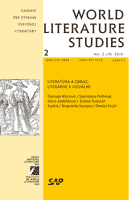Štúdiá vizuálnej kultúry a postkomunistická identita? Skúmanie obrazu v kontexte spoločenskej transformácie
VISUAL CULTURE STUDIE S AND POSTCOMMUNIST STUDIES? EXPLORATION OF ANIMAGE IN THE CONTEXT OF SOCIAL TRANSFORMATION
Author(s): Daniel GrúňSubject(s): Literary Texts
Published by: SAV - Slovenská akadémia vied - Ústav svetovej literatúry
Keywords: Visual Culture. Postcommunism. Transformation. Identity. Memory. Modern History.
Summary/Abstract: The study aims to explore the potential behind the visual culture in the post-socialist countries of former Eastern Europe in terms of social transformation and processes associated with the fall of the communist regime. The study presses to challenge the concept of “visual culture” in relation to such notions as ideology, memory, iconoclasm, public institutions, or public space. Do the socialist institutions fall within the scope of competence assumed by visual/cultural studies? If they do, then what methods and concepts are available to employ in an effort to explore the “iconosphere” linked to the building of socialism, the collapse of one political system and a consequent political, economical and social transformation? What relationship will visual studies espouse in relation to such traditional fields as art history? What form will the writing on image production in the period of totalitarian ideologies viewed from contemporary perspectives take? It shall be treading the territory shared by multiple fields and it will attempt to tie in on the results which interdisciplinary research in visual culture and post-communist identity have yielded. Current trends in the arena of exhibition projects, publications and new university courses attest to a lively debate that branches various levels of the Central European community in terms of this subject matter. The charted approach does not merely admit diversity of employed methods, interdisciplinary engagement and plurality of opinions; it directly presumes it. With the aforementioned in mind, the study will not consider so much the global perspective but will rather outline a few local underlying aspects of the “contemporary past”. It also aspires to focus on the issues of critical thinking by exploring the images and visual culture from a viewpoint of social landmarks.
Journal: World Literature Studies
- Issue Year: II/2010
- Issue No: 2
- Page Range: 70-81
- Page Count: 12
- Language: Slovak

